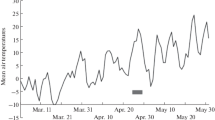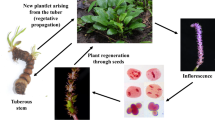Abstract
Investigating the tolerance of plant reproductive systems to environmental changes has become a research priority under current climate change scenarios. Successful plant conservation requires knowledge of plant reproductive biology, particularly the meiotic characteristics of planted species. Meiosis, as part of microsporogenesis, is a critical plant developmental stage controlling future pollen quality. Meiosis in a Siberian fir (Abies sibirica) plantation, established in the Forest Arboretum of the Sukachev Institute, Russia, was studied from 2002 to 2004. The microsporogenesis pattern found for the Siberian fir appeared to be largely similar to that exhibited by other conifer species. Meiosis in the Siberian fir has the following characteristics: asynchrony, rapid progression of telophases I and II, and parallel and linear spindle arrangements at different meiosis II stages. General and specific meiosis irregularities were recorded at each stage. Some specific features of meiosis and the specific development of some irregularities were revealed. Pollen development analysis showed that irregular pollen grains made up less than 1% of all grains. The specific features of meiosis identified in fir trees growing in the Arboretum indicated low resistance of male reproductive structures to climatic changes and might account for high fir pollen sterility in this new environment.






Similar content being viewed by others
References
Andersson E (1980) Temperature-conditioned irregularities in pollen mother cells of Picea abies (L.) Karst. Hereditas 92:27–35
Bazhina EV, Kvitko OV, Muratova EN (2007) Meiosis at microsporogenesis and pollen viability in Siberian fir (Abies sibirica Ledeb.) in the Middle Eastern Sayan mountains. Russ For Sci (Lesovedenie) 1:57–64
Bogdanov YuF (2003) Variability and evolution of meiosis. Russ J of Genet (Genetika) 39(4):363–381
Box EO, Crumpacker DW, Hardin PS (1999) Predicted effects of climatic change on distribution of ecologically important native tree and shrub species in Florida. Climatic change 41:213–248
Butorina AK, Muraya LS, Mashkina OS et al (1985) A new type of meiotic mutation in the pine. Russ J Genet (Genetika) 21(1):103–111
Chandler C, Mavrodineanu S (1965) Meiosis in Larix laricina Koch. Contrib Boyce Thompson Inst 23(4):67–76
Charlesworth D, Willis JH (2009) The genetics of inbreeding depression. Nat Rev Genet 10:783–796
Chira E (1964) Vplyv teploty na pribeh meiozy pelovych materskych buniek Taxus bassata L (The temperature influence on Taxus bassata L. meiosis). Biologia, Bratislava 11(4):235–243
Christiansen H (1960) On the effect of low temperature on meiosis and pollen fertility in Larix decidua Mill. Silvae Genet 9(3):72–78
Core WT, Pachauri RK, Reisinger A (eds.) (2007) Climate change 2007: synthesis report. IPCC, Geneva. http://www.ipcc.ch/publications_and_data/publications_and_data_reports.htm
Eriksson G (1968) Temperature response of pollen mother cells in Larix and its importance for pollen formation. Stud For Suec 63:1–131
Gavrilov IA, Butorina AK (2005) Cytogenetics of the Canadian Hemlock upon introduction in the Voronezh district. Russ For Sci (Lesovedenie) 3:60–65
Golubovskaya IN (1975) Genetic control of chromosome behavior during meiosis. In: Khvostova VV, Bogdanov YuF (eds) Tsitologiya i genetika meioza (Cytology and genetics of meiosis). Nauka, Moscow, pp 312–322
Gordon C, Cooper C, Senior C et al (2000) The simulation of SST, sea-ice extent and ocean heat transport in a version of the Hadley Centre coupled model without flux adjustments. Climatic Dyn 16:147–168
Hak O, Russell JH (2004) Environmental effects on Yellow-cedar pollen quality. Forest Genetic Council Extension note 05:1–9
Hulme M, Mitchell JFB, Ingram W et al (1999) Climate change scenarios for global impacts studies. Glob Environ Change 9:3–19
Iverson LR, Prasad AM (1998) Predicting abundance of 80 tree species following climate change in the Eastern United States. Ecol Monographs 68(4):465–485
Johnsson A (1974) A study on the temperature response of pollen mother cells in Norway spruce. Stud For Suec 116:1–32
Khvostova VV, Yachevskaya GL (1975) Chromosome rearrangements in meiosis. In: Khvostova VV, Bogdanov YuF (eds) Tsitologiya i genetika meioza (Cytology and genetics of meiosis). Nauka, Moscow, pp 232–262
Loskutov RI (1993) Dekorativnye drevesnye rasteniya dlya ozeleneniya gorodov i poselkov (Decorative tree plants for greenery of towns and settlements). Izd-vo Krasnoyarskogo instituta lesa, Krasnoyarsk
Luomajoki A (1977) Effects of temperature on Spermatophyte Male Meiosis. Hereditas 85:33–48
Luomajoki A (1986) Timing of microsporogenesis in trees with reference to climatic adaptation. Acta For Fenn 196:1–33
Mahneva SG, Babushkina LG, Zueva GV (2003) Sostoyanie muzhskoy generativnoy sphery Pinus sylvestris pri technogennom zagryznenii sredy (The state of Pinus sylvestris male generative sphere at technogenic pollution of environment). Ural university publisher, Ekaterinburg
Mamaev SA, Andreev LN (1996) Role of botanical gardens of Russia in conservation of floristic diversity. Russ J of Ecol (Ekologia) 6:432–437
Mamaev SA, Dorofeeva LM, Alexandrova MS et al (1993) Adaptacia i izmenchivost dreveshych rastenii lesnoy zone Evrasii (Adaptation and variability of woody plant in forest zone of Eurasia). Nauka, Ekaterinburg
Mehra RC, Rai KS (1970) Cytogenetic studies of meiotic abnormalities in Collinsa tinctoria. I. Chromosomal stikness. Can J Genet Cytol 12(4):560–569
Mergen F, Lester DT (1961) Microsporogenesis in Abies. Silvae Genet 10(5):146–156
Mok DWS, Peloquin SJ (1975) Three mechanisms of 2n pollen formation in diploid potatoes. Can J Genet Cytol 17(2):217–225
Muratova EN (1995) Specific features of meiosis in Scots pine near the northern boundary of its range. Russ J Dev Biol (Ontogenez) 26(2):128–139
Muratova EN, Matveeva MV (1996) Caryological features of the Siberian Fir under different conditions of growing. Russ J of Ecol (Ekologia) 2:96–102
Muraya LS, Butorina AK, Dudetskaya EM (1988) Meiosis during microsporogenesis and development of male gametophyte in the Chinese Douglas fir upon introduction. Russ For Sci (Lesovedenie) 5:37–44
Nekrasov VI (1971) Some theoretical problems of the formation of introduced populations of forest trees. Russ For Sci (Lesovedenie) 5:26–30
Nekrasova TP, Ryabinkov AP (1978) Plodonoshenie pychty sibirscoi (Abies sibirica seed production). Nauka, Novosibirsk
Owens JN, Molder M (1985) The reproductive cycles of true firs. Information Services Branch Ministry of Forests, Victoria, British Columbia, 35 pp
Pozhidaeva IM, Butorina AK, YuN Isakov (1985) Defects of meiosis during microsporogenesis and level of fertility in the Scots pine. In: Nekrasova TP (ed) Polovoe razmnozhenie khvoinykh rastenii (Sexual reproduction of coniferous plants). Nauka, Novosibirsk, p 31
Rozhdestvenskii YuF (1974) Specific features of microsporogenesis in the Scots pine in the Urals and its dependence on ecological factors. Russ J of Ecol (Ekologia) 1:49–53
Shkutina FM (1975) Meiosis in remote hybrids and amphiploids. In: Khvostova VV, Bogdanov YuF (eds) Tsitologiya i genetika meioza (Cytology and Genetics of Meiosis). Nauka, Moscow, pp 263–283
Sosnikhina SP, Fedotova YuS, Smirnov VG et al (1994) A study of genetic control of meiosis in the rye. Russ J Genet (Genet) 30(8):1043–1056
StatSoft, Inc. STATISTICA (2001) Data analysis software system, version 6. http://www.statsoft.com
Tretyakova IN, Bazhina EV (2000) Structure of crown as well as pollen and seed viability of fir (Abies sibirica Ledeb.) in disturbed forest ecosystems of the Khamar-Daban Mts. Ecology Bratislava 19(3):280–294
Varpholomeev IV, Maltsev YuM (eds) (2006) Gosudarstvennii doklad O sostoyanii i ohrane okruzhajuscheii sredii v Krasnoyarskom kraye v 2006 (State report about environmental status and protection in Krasnoyarsk region in 2006). Priroda, Krasnoyarsk
Veileux RE, McHale NA, Lauer FI (1982) 2n gametes in diploid solanum: frequency and types of spindle abnormalities. Can J Genet Cytol 24(3):301–314
Acknowledgments
This research was supported by the Russian Foundation of Basic Research-Krasnoyarsk Region Foundation of Science Support (grants No 09-04-98000, r_sibir_a).
The authors are grateful to the editor and two anonymous reviewers who provided valuable comments on the manuscript as well as the organisers of the EUROGARD V conference for linguistic improvements.
Author information
Authors and Affiliations
Corresponding author
Rights and permissions
About this article
Cite this article
Bazhina, E.V., Kvitko, O.V. & Muratova, E.N. Specific features of meiosis in the Siberian Fir (Abies sibirica) in the forest Arboretum of the V. N. Sukachev Institute, Russia. Biodivers Conserv 20, 415–428 (2011). https://doi.org/10.1007/s10531-010-9958-y
Received:
Accepted:
Published:
Issue Date:
DOI: https://doi.org/10.1007/s10531-010-9958-y




